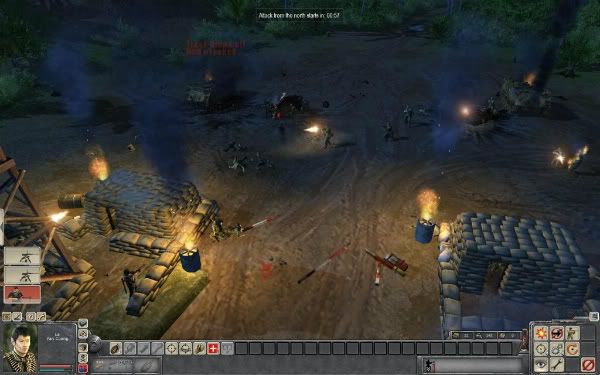This post has not been edited by the GamesBeat staff. Opinions by GamesBeat community writers do not necessarily reflect those of the staff.
Men of War: Vietnam opens with an acoustic guitar sounding to a series of black-and-white images. Open-top military jeeps carry soldiers with blank stares that project their broken spirits onto anyone who dares glare in their direction.

An electric organ plays a meandering melody that underscores an Apache gunship overlooking the dense jungle and indiscriminately firing at anyone on the ground. The roar of a F-4 Phantom with a teeth-bearing shark's mouth painted over the nose drops a payload of flesh-melting napalm that kicks off a relentless beat accompanied by triumphant power chords.
This introduction draws inspiration from the war footage and the prevailing psychodelic rock that colored the late '60s and early '70s, a time when U.S. soldiers sent to Vietnam came back with tales of being "in the shit." MOW: Vietnam is like being in the shit for video games. 1C Company's latest PC strategy title, similar to its predecessors, throws players into a raging battlefield without the slightest concern for their preparedness.
Did you know that MOW: Vietnam uses Shift-plus-a-number to create control groups, which is quite different from the well-established Ctrl-plus-a-number? Did you know that you can press backspace to slow down or speed up the pace of the game? Did you know that you can hold Ctrl to enter direct-control mode for the selected soldier? Did you realize that the game defaults to issuing orders with the left mouse button rather than the much more common right mouse button for real-time strategy titles?
Neither did I…until I read the tool-tips during the loading screens after one of my many failures. MOW: Vietnam opens fast and fierce. No one helps you — in fact, unlike previous Men of War games, you can't even call in reinforcements.

These interface flaws have the fortune of unintentionally but successfully inducing the panic and confusion of that era, and this provides an opening glimpse into how MOW: Vietnam evokes the feelings of the Cold War-era proxy conflict. In the field and at home, American soldiers and citizens alike weren’t prepared for the arduous road on which their elected officials had set them. And as the conflict’s media presence grew, so did the nation's discomfort.
Unlike previous wars, Vietnam was not so conventional. Guerrilla tactics ruled the battlefield. Soldiers laid traps for their adversaries. Stealthy ambushes were more effective than direct confrontation. 1C Company has clearly built MOW: Vietnam with these new axioms of combat in mind.
In each of the two campaigns (one from the North Vietnamese perspective, where players command a squad that includes Soviet military advisors, the other through the eyes of a U.S. special forces unit), the enemy outguns and outnumbers the player. This time around, scavenging for ammunition and weapons becomes paramount to success precisely because the squad is cut off from command.
Open battlefields did not pervade the real-world conflict, and their presence is likewise scarce in MOW: Vietnam, too; marching through the vegetation can quickly disorientate would-be squad leaders, which only adds to the confusion of war. The dense jungle easily conceals not just players' soldiers but their enemies, too.

Deadly landmines lie in wait for the foolishly impatient. Hidden snipers suppress movement through the overgrowth. Players need to survey their surroundings because such inattentiveness can be incredibly costly. A dead man is irreplaceable (although, squaddies "regenerate" after completing a mid-mission objective…I suppose we can assume that these grunts are a part of the Universal Soldier program). MOW: Vietnam makes this doubly difficult because of the aforementioned low visibility. As in war, mistakes are unforgiving.
I’m in a world of shit…yes. But I am alive. And I am not afraid.
January 29, 1968. In the pitch blackness of night, my four-man squad needs to reclaim the bridge over the River Mekong. We occupy a small camp just south of our objective; if we don’t act quickly, American infantry and armor will make their way north over the crossing, which would cause our escape to become much more difficult.

The Americans have dug in deep around the overpass: Sandbags protect two machine-gun (MG) nests and offer cover to soldiers equipped with M-16s and mortars. In light of this, we decide to sneak through the jungle, swim across the river, and launch a surprise attack from the other side of the water.
We hit the Americans with deadly precision. Two soldiers with scoped rifles set up at the edge of the tree line while another two crawl through the overgrowth to get as close as possible. As they lob several grenades over the sandbag barrier, the riflemen open fire. The Americans panic and begin blind-firing in all directions as we run back to regroup.
The hit-and-run tactic worked. We circle around for a second attack while avoiding enemy flares hoping to illuminate our location. Once clearing this side of the bridge, we commandeer two .30 cal machine guns, turn their sights around, and paint the ground red. No American survives.

With the bridge secured, we now have a defensible position to hold back the U.S. forces coming up from the south. We ready our looted single-shot bazookas, mortars, and MG nests. As the enemy armor breaches the muddy ground in front of the tree line, a distorted guitar playing a menacing riff swells in the background.
This is the end. My only friend, the end.
